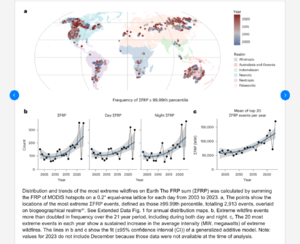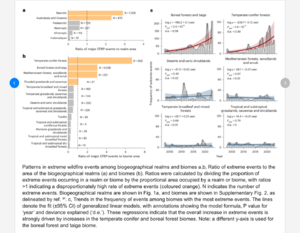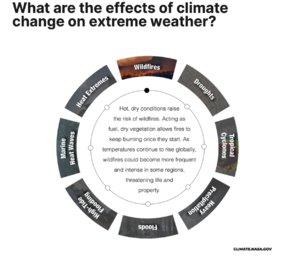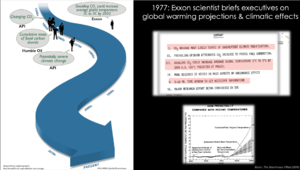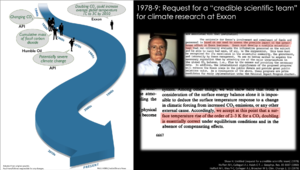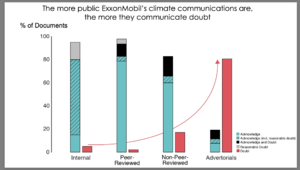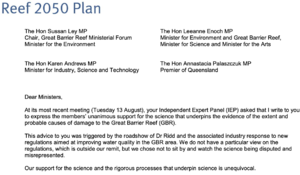Kan du ikke heller argumentere sak, istedenfor personkarakteristikker.Hva f er det du vil fram til?
Noen forskere studerer de største skogbrannene, og ditt ankepunkt er at de bare studerer 0.01%, det er akkurat det de studerer.
Om du har en høyere utdannelse med en grad, bør du be om å få dine utgifter refundert, akademisk tenkning har du iallefall ikke tillegna deg.
Politikk, religion og samfunn Klimaforskerne regnet rett Hva nå?
- Trådstarter Hardingfele
- Startdato
Diskusjonstråd Se tråd i gallerivisning
-
???Kan du ikke heller argumentere sak, istedenfor personkarakteristikker.
Du argumenterer mot å forske på de største og farligste skogbrannene.
Lite saklig og lite akademisk mener jeg..
Om du mener det er personkarakteristikker, vel deg om det!
Men siden ingen av oss flagger våre riktige navn her, kanskje vi møtes på Horten messa og trives jækla godt sammen?- Ble medlem
- 28.09.2016
- Innlegg
- 11.496
- Antall liker
- 11.473
Jeg opplever vel her at du snur hele saken fullstendig på hodet. Klimaendringer medfører et stort sett av endringer, og dette viser seg på mange måter, selv om alt sammen koker ned til en eneste årsakssammenheng; CO2, økende drivhuseffekt, dermed økende temperatur. Med dette utgangspunkt får vi: mer vær, mer vind, mer tørke, mer flom, mer skogbrann, surere hav, utryddelse av dyr og planter, nedsmelting av isbreer, problemer med matforsyning, og jeg kan fortsette i det uendelige.Ja, jeg ser jo at dette er din holdning, og at ingen enkeltdeler/undersøkelser/artikler kan diskuteres separat.
Jeg synes det er dumt at du/hønnet/fela umiddelbart jammer ned enhver diskusjon med å rope det samme på nytt, på nytt, på nytt og på nytt.
I din verden er det mye viktigere å isolere ett enkelt bitte lite felt, og så beklage deg over at regnestykket på akkurat dette feltet er satt opp annerledes enn du ville gjort det. I realiteten er det rasende irrelevant, klimaendringene er her for å bli, og vi må finne måter å håndtere dem på.jeg misunner de her inne som vokste opp med en moder jord i balanse, virker så harmonisk. Ingenting gikk galt og man hadde ikke behov for allværsjakke
snøen kom som bestilt hver vinter og smeltet akkurat i tide, avlingene fikk perfekte forhold og høsten kom første dag i høstferien
I dag kan det være sol en dag og regn neste, noen ganger mange dager på rad
Jeg syns det er veldig slitsomt og vanskelig å forholde seg til- Ble medlem
- 28.09.2016
- Innlegg
- 11.496
- Antall liker
- 11.473
Ja nu va du smart. Nu va du vældi smart!jeg misunner de her inne som vokste opp med en moder jord i balanse, virker så harmonisk. Ingenting gikk galt og man hadde ikke behov for allværsjakke
snøen kom som bestilt hver vinter og smeltet akkurat i tide, avlingene fikk perfekte forhold og høsten kom første dag i høstferien
I dag kan det være sol en dag og regn neste, noen ganger mange dager på rad
Jeg syns det er veldig slitsomt og vanskelig å forholde seg tilInteressant artikkel, ut fra sammendraget og de utdragene jeg har funnet. De viser tydelig at antallet riktig intense skogbranner øker ganske bratt. De viser også at det meste av økningen er i nordlig barskog. Det er vel omtrent som man skulle forvente i et scenarie hvor det blir varmere, med raskest oppvarming i Arktis.



At brent areal ikke øker like mye kan ha noe med hvor mye ressurser som brukes på brannslukking når det først setter i gang, også det knyttet til hvor det brenner.
Metodikken ser ut til å være drevet av at de bruker satellittdata. Det er godt egnet til å filtrere på utstrålt energi, men kanskje ikke like egnet for å måle brent areal eller totalt antall. Hvert artillerinedslag i Ukraina vil lyse opp som et hot spot i MODIS-data, så det virker fornuftig å fokusere på de mest intense skogbrannene for å unngå å få med alt mulig annet i datasettet.Sist redigert:
Flott innlegg. Elles: Mr Sealion Rides AgainInteressant artikkel, ut fra sammendraget og de utdragene jeg har funnet. De viser tydelig at antallet riktig intense skogbranner øker ganske bratt. De viser også at det meste av økningen er i nordlig barskog. Det er vel omtrent som man skulle forvente i et scenarie hvor det blir varmere, med raskest oppvarming i Arktis.
Vis vedlegget 1038279
Vis vedlegget 1038280
Vis vedlegget 1038282
At brent areal ikke øker like mye kan ha noe med hvor mye ressurser som brukes på brannslukking når det først setter i gang, også det knyttet til hvor det brenner.
Metodikken ser ut til å være drevet av at de bruker satellittdata. Det er godt egnet til å filtrere på utstrålt energi, men kanskje ikke like egnet for å måle brent areal eller totalt antall. Hvert artillerinedslag i Ukraina vil lyse opp som et hot spot i MODIS-data, så det virker fornuftig å fokusere på de mest intense skogbrannene for å unngå å få med alt mulig annet i datasettet.
Må ikke poste slike tabeller.Interessant artikkel, ut fra sammendraget og de utdragene jeg har funnet. De viser tydelig at antallet riktig intense skogbranner øker ganske bratt. De viser også at det meste av økningen er i nordlig barskog. Det er vel omtrent som man skulle forvente i et scenarie hvor det blir varmere, med raskest oppvarming i Arktis.
Vis vedlegget 1038279
Vis vedlegget 1038280
Vis vedlegget 1038282
At brent areal ikke øker like mye kan ha noe med hvor mye ressurser som brukes på brannslukking når det først setter i gang, også det knyttet til hvor det brenner.
Metodikken ser ut til å være drevet av at de bruker satellittdata. Det er godt egnet til å filtrere på utstrålt energi, men kanskje ikke like egnet for å måle brent areal eller totalt antall. Hvert artillerinedslag i Ukraina vil lyse opp som et hot spot i MODIS-data, så det virker fornuftig å fokusere på de mest intense skogbrannene for å unngå å få med alt mulig annet i datasettet.
Sylvi Listhaug og Carl Ivar vil bruke den til å fremheve FRP's økende oppslutning siden 2008 frem til i dag.NASA har laget en grei oversikt, som klimatullingene bør kasteseg over for å tilbakevise, for hva vet vel NASA om slikt. (Carl I Hagen mente at de overdrev med vilje, mens NASA selv peker på at de faktisk har vært på etterkant i forhold til faktisk utvikling. Hvem skal vi feste lit til, tro, som beste veiviser inn i fremtiden?)
Klikk på linken for å komme til animasjonen. Poenget er nettopp de ekstreme utfallene, som er større, kommer hyppigere og er mer ødeleggende enn hva man har sett tidligere. Helt nye områder rammes, infrastruktur man trodde var trygg blir utsatt, rasfare og flom på steder man ikke har opplevd slikt før, osv.
Men klimadottene kommer med sine rare innsigelser og påstander, som alle handler om å forsøke å frikjenne CO2 fra fossile energikilder som hovedårsak til oppvarmingen. Dem om det.
ExtremeEventsGraphic.mp4

Nei, jeg har ikke argumentert mot å forske.???
Du argumenterer mot å forske på de største og farligste skogbrannene.
Lite saklig og lite akademisk mener jeg..
Jeg har diskutert metodikken i en spesifikk artikkel.
Dette er vel personkarakteristikker:Om du mener det er personkarakteristikker, vel deg om det!
Men siden ingen av oss flagger våre riktige navn her, kanskje vi møtes på Horten messa og trives jækla godt sammen?
Skriver ikke her rett ut at du synes det er merkelig å måle/forske på de største og mest farlige brannene?
Om en av oss har kognitiv svikt på linje med amerikanske president kandidater så er det ikke meg.OMF prøver iallefall å argumentere for sine vrangforestillinger i motsetning til amason.
I min verden er begge helt ute på viddene.
Mitt nick er forøvrig mine initialer og jeg har aldri prøv å skjule hvem jeg er her - så det finner du ut på mindre enn 5 minutter om du forsøker.Om du har en høyere utdannelse med en grad, bør du be om å få dine utgifter refundert, akademisk tenkning har du iallefall ikke tillegna deg.
I denne tråden så er vel mitt "bidrag" at jeg prøver å sette meg inn i det som postes og prøver å diskutere en konkret sak. I min verden er klimaendring tusenvis av prosesser som i større og mindre grad er flettet inn i hverandre. Jeg synes det er interessant å se på metodikk og resultater.Jeg opplever vel her at du snur hele saken fullstendig på hodet. Klimaendringer medfører et stort sett av endringer, og dette viser seg på mange måter, selv om alt sammen koker ned til en eneste årsakssammenheng; CO2, økende drivhuseffekt, dermed økende temperatur. Med dette utgangspunkt får vi: mer vær, mer vind, mer tørke, mer flom, mer skogbrann, surere hav, utryddelse av dyr og planter, nedsmelting av isbreer, problemer med matforsyning, og jeg kan fortsette i det uendelige.
I din verden er det mye viktigere å isolere ett enkelt bitte lite felt, og så beklage deg over at regnestykket på akkurat dette feltet er satt opp annerledes enn du ville gjort det. I realiteten er det rasende irrelevant, klimaendringene er her for å bli, og vi må finne måter å håndtere dem på.
Jeg har forlengs skjønt at du ikke ønsker en slik diskusjon og gjør det du kan for å jamme ned alle former for diskusjon med å rope høyest mulig "mer vær, mer vind, mer tørke, mer flom, mer skogbrann, surere hav, utryddelse av dyr og planter, nedsmelting av isbreer, problemer med matforsyning, og jeg kan fortsette i det uendelige."
Mens jeg synes det er interessant å se på feks "får vi mer skogbrann?" som du postulerer som en selvfølge - men er det slik. Om du ser på kartet som Asbjørn postet - så ser du at det brenner ikke så mye rundt ekvator -> og for å ta et banalt eksempel - om global oppvarming gjør hele jorden til Sahara - så vil det jo ikke bli mer skogbranner.
I det store og hele så er skogbranner - selv om det er en liten del av hele bildet, veldig komplisert.
- Hvordan skal man måle hvor mye det brenner - antall branner, areal brent eller energi sluppet ut.
- Skal man måle i absolutte tall, eller skal man regne som andel av tilgjengelig biomasse
- Hvordan skal man håndtere menneskelig inngripen - både slukkearbeid, ildpåsettelse og begrensningsarbeid i form av skogvern
- Hvordan ta høyde for naturlige sykluser, hvor noe brenner ned med jevne mellomrom, før det vokser opp igjen.
Forrige gang vi så på dette, var det vel enighet om brent areal i hvertfall ikke var økt. Tallene vi så på da viste vel litt det samme som Asbjørn poster lengre opp at det var en økning i skogbranner der det var skog (!), mens en nedgang i branner der det var mer kratt/slette - som igjen står for de store arealene. Denne rapporten viser tilsynelatende det samme.
Godt å se at du tar deg tid til et lite stikk.Flott innlegg. Elles: Mr Sealion Rides Again
Kan ikkje bruka all tida mi på å selja olje, feitt og tilsetningar veit du.Godt å se at du tar deg tid til et lite stikk.- Ble medlem
- 28.09.2016
- Innlegg
- 11.496
- Antall liker
- 11.473
OK, da skjønner jeg litt mer av driverne for ditt fokus.I denne tråden så er vel mitt "bidrag" at jeg prøver å sette meg inn i det som postes og prøver å diskutere en konkret sak. I min verden er klimaendring tusenvis av prosesser som i større og mindre grad er flettet inn i hverandre. Jeg synes det er interessant å se på metodikk og resultater.
Jeg har forlengs skjønt at du ikke ønsker en slik diskusjon og gjør det du kan for å jamme ned alle former for diskusjon med å rope høyest mulig "mer vær, mer vind, mer tørke, mer flom, mer skogbrann, surere hav, utryddelse av dyr og planter, nedsmelting av isbreer, problemer med matforsyning, og jeg kan fortsette i det uendelige."
Mens jeg synes det er interessant å se på feks "får vi mer skogbrann?" som du postulerer som en selvfølge - men er det slik. Om du ser på kartet som Asbjørn postet - så ser du at det brenner ikke så mye rundt ekvator -> og for å ta et banalt eksempel - om global oppvarming gjør hele jorden til Sahara - så vil det jo ikke bli mer skogbranner.
I det store og hele så er skogbranner - selv om det er en liten del av hele bildet, veldig komplisert.
- Hvordan skal man måle hvor mye det brenner - antall branner, areal brent eller energi sluppet ut.
- Skal man måle i absolutte tall, eller skal man regne som andel av tilgjengelig biomasse
- Hvordan skal man håndtere menneskelig inngripen - både slukkearbeid, ildpåsettelse og begrensningsarbeid i form av skogvern
- Hvordan ta høyde for naturlige sykluser, hvor noe brenner ned med jevne mellomrom, før det vokser opp igjen.
Forrige gang vi så på dette, var det vel enighet om brent areal i hvertfall ikke var økt. Tallene vi så på da viste vel litt det samme som Asbjørn poster lengre opp at det var en økning i skogbranner der det var skog (!), mens en nedgang i branner der det var mer kratt/slette - som igjen står for de store arealene. Denne rapporten viser tilsynelatende det samme.
Det er vel fair enough å være opptatt av detaljene i det store bildet, mulig jeg har feiltolket deg, men det oppfattes fra min side som om du forsøker å desavuere hele vitenskapen omkring klimaendringene ved å påpeke det du oppfatter som avvik eller feil i vitenskapelige utlegninger om et eller annet tema relatert til klimaspørsmålene.
Mitt ståsted er dermed i den motsatte ende; det samlede bevismateriale er såpass overbevisende og massivt at en petimeterdebatt om detaljene i enkeltartikler kjennes nokså meningsløst. For meg dreier det seg om et sett realiteter vi må vi forholde oss til, dermed er det av mye større interesse å se framover, fremfor å dykke ned i det jeg oppfatter som ganske meningsløs ridning av kjepphester på detaljnivå. Så om skogbrannene er større/mindre/flere/færre/mer eller mindre intense i nord eller sør, og hva som eventuelt er den endelige årsakssammenhengen til disse resultatene, oppleves som av kun akademisk interesse. For meg blir spørsmålet mye mer hvordan vi skal forholde oss til de trendene vi ser. Eksempel: Sett at antallet skogbranner går ned, men at vi har bygget hus og infrastruktur på en slik måte at mange fler boliger og industribygg brenner ned, hvordan skal vi i så fall forholde oss til dette? Bør vi bygge annerledes? Må vi tenke annerledes på preventive og akutte slukketiltak? Osv.
Uansett er det min oppfatning at så lenge temperaturen går opp og antallet tilfeller av tørke øker, så vil det øke faren for skogbrann. Jeg behøver ikke detaljene i en vitenskapelig avhandling for å fatte såpass.
Neida, du leverer stabilt og godt - hver gang det er en diskusjon, så styrer du fint unna sak og kommer med et lite stikk.Kan ikkje bruka all tida mi på å selja olje, feitt og tilsetningar veit du.
Fint- dette har jeg skrevet veldig mange ganger her inne da - så det er litt rart at du ikke har skjønt det før nå.OK, da skjønner jeg litt mer av driverne for ditt fokus.
Det har jeg skjønt:Mitt ståsted er dermed i den motsatte ende;
Men når du overhodet ikke er interessert - hvorfor involverer du deg i en diskusjon om akkurat dette - siden du åpenbart har null interesse i detaljene?Så om skogbrannene er større/mindre/flere/færre/mer eller mindre intense i nord eller sør, og hva som eventuelt er den endelige årsakssammenhengen til disse resultatene, oppleves som av kun akademisk interesse.
Vel - da vil jeg anta at du må ned på en " petimeterdebatt om detaljene i enkeltartikler" - noe som du oppfatter som meningsløst.Eksempel: Sett at antallet skogbranner går ned, men at vi har bygget hus og infrastruktur på en slik måte at mange fler boliger og industribygg brenner ned, hvordan skal vi i så fall forholde oss til dette? Bør vi bygge annerledes? Må vi tenke annerledes på preventive og akutte slukketiltak? Osv.
Nei, du har jo bestemt deg.Uansett er det min oppfatning at så lenge temperaturen går opp og antallet tilfeller av tørke øker, så vil det øke faren for skogbrann. Jeg behøver ikke detaljene i en vitenskapelig avhandling for å fatte såpass.
Skjønner du at man kan være kritisk til en del av katastroferopingen - uten at det innebærer å ikke tro på mekanismene rundt global oppvarming og at det faktisk blir varmere. Eller tenker du at man må istemme alt, rope høyest, hver gang hele tiden for å være på rett side?- Ble medlem
- 28.09.2016
- Innlegg
- 11.496
- Antall liker
- 11.473
Har ikke noe med katastrofetanker å gjøre, her misforstår du meg nok. Jeg er teknologioptimist, og for å komme noen vei med å løse problemene som nå oppstår i stadig økende grad, må vi fokusere på løsninger fremfor å krangle om småtterier. Kort sagt må vi både drive skadeforbygging/begrensning samtidig som vi må utvikle teknologi for å tvinge CO2-utslippene ned. Langt, langt ned. Da har vi ikke tid til så mye annet, egentlig. Og sånn sett er idiotiske kriger i Ukraina og MidtØsten fryktelig kontraproduktivt, for sånt har vi mennesker ganske enkelt ikke tid til akkurat nå.Fint- dette har jeg skrevet veldig mange ganger her inne da - så det er litt rart at du ikke har skjønt det før nå.
Det har jeg skjønt:
Men når du overhodet ikke er interessert - hvorfor involverer du deg i en diskusjon om akkurat dette - siden du åpenbart har null interesse i detaljene?
Vel - da vil jeg anta at du må ned på en " petimeterdebatt om detaljene i enkeltartikler" - noe som du oppfatter som meningsløst.
Nei, du har jo bestemt deg.
Skjønner du at man kan være kritisk til en del av katastroferopingen - uten at det innebærer å ikke tro på mekanismene rundt global oppvarming og at det faktisk blir varmere. Eller tenker du at man må istemme alt, rope høyest, hver gang hele tiden for å være på rett side?
Ikke uenig i dette - men jeg synes som sagt det er av interesse å gå litt mer i detaljene - sakskomplekset er vel langt på vei det mest kompliserte/sammensatte vi mennesker prøver å modellere - og da synes jeg det er dumt om man har "default"/bestemt seg på forhånd at alt blir verre.Har ikke noe med katastrofetanker å gjøre, her misforstår du meg nok. Jeg er teknologioptimist, og for å komme noen vei med å løse problemene som nå oppstår i stadig økende grad, må vi fokusere på løsninger fremfor å krangle om småtterier. Kort sagt må vi både drive skadeforbygging/begrensning samtidig som vi må utvikle teknologi for å tvinge CO2-utslippene ned. Langt, langt ned. Da har vi ikke tid til så mye annet, egentlig. Og sånn sett er idiotiske kriger i Ukraina og MidtØsten fryktelig kontraproduktivt, for sånt har vi mennesker ganske enkelt ikke tid til akkurat nå.
Som en anekdote - uten tilknytning til dette - så er nå Great Barrier Reef på all time high - aldri vært bedre. Det betyr ikke at det ikke blir varmere og slikt, men at jorden reagerte litt annerledes enn man trodde for noen år siden.
…som du ikke har lest.Jeg har diskutert metodikken i en spesifikk artikkel.
Ja, det skrev jeg i første innlegg om saken - at jeg kun hadde lest "abstract" - som beskriver metodikken.…som du ikke har lest.
Edit: men om du har funnet hele så del gjerne en link her.…som du ikke har lest.
He-he. OMF kan lese dette. Det er Exxons grundige studieoppsummering fra 1979, der de forutser CO2-andelen som vil øke i atmosfæren, og hva denne vil føre til.
PDF: https://www.worthingtoncaron.com/documents/1979-OCT.-16-1979_“CONTROLLING-THE-CO2-CONCENTRATION.pdf
Det er riktignok mange sider, men OMF kan bruke sin hang til å ta tak i detaljer for å vise hvor Exxon tar feil og hvorfor global oppvarming skyldes skyer, vulkaner, solen (som OMF har vært innom mange ganger). Jeg merker meg at det er slutt på henvisninger til "mer is ved Antarktis" og påstander om at "det vil bli kaldere". Litt virkelighetsinnsnikning i verdensbildet har tross alt skjedd i løpet av de seneste fjorten årene med hans innsigelser.
Og så kan OMF se på denne rapporten, utarbeidet av forskere ved Harvard og bl.a. presentert for EU-kommisjonen.
Meget lettilgjengelig og viser 1) hva oljeselskapene har visst - og 2) hva oljeselskapene har gjort for å få klimadotter, -tufser og -tullinger til å bli nyttige idioter for bransjens mål om å utvinne mest mulig fossil energi før det blir for dyrt og konsekvensene for tydelige.
PDF: https://www.europarl.europa.eu/cmsdata/162144/Presentation Geoffrey Supran.pdf
Etter en gjennomgang av sistnevnte oversiktlige rapport bør man sitte igjen og være inderlig eitrende forbannet over hva som er blitt gjort med klodens klimabalanse, i den kortsiktige profittens navn.
Hva visste man, hva gjorde man? Oljeselskapene selv fastslo og utviklet vitenskapen, konkluderte med CO2s innvirkning på klodens snittemperatur og at økningen ville endre klimabalansen og nedsatte forskerteam som skulle se på konsekvensene, og som gjorde forbausende nøyaktige forutsigelser om utviklingen. Men så er jo ikke dette veldig vanskelig vitenskap -- om man ikke er en klimadott, -tulling eller -tufs som er blitt gjort til nyttig idiot av hva oljeselskapene gjorde i neste omgang, så forstår man at med økende CO2-nivå vil man også få økende temperatur på kloden.




Nei, har ikke funnet hele, men jeg fant grafene og førstesiden herfra:Ja, det skrev jeg i første innlegg om saken - at jeg kun hadde lest "abstract" - som beskriver metodikken.
Edit: men om du har funnet hele så del gjerne en link her.
Det står tilnærmet ingen ting om metodikken i sammendraget, forresten.Jeg legger denne i et separat innlegg.
Exxons interne forskning, avveining mellom den som fastslår at klimkonsekvensene av økte CO2-utslipp er fastslått/anerkjent, kontra hvorvidt det er tvil om samme, sammenlignet med fagfellevurderte rapporter, ikke-fagfellevurderte rapporter og andelen såkalte "advertorials" betalt av oljeindustrien (spesielt av Exxon), som skulle så tvil om forskningen Exxons forskere hadde fastslått var korrekt.
Advertorial: omfattende plassering av annonser, gjerne over flere sider, med påstander som imøtegår vitenskapelige konklusjoner om CO2s effekt på global snittemperatur.

by calculating daily clusters of summed fire radiative power using 21 years of satellite data, revealing that the frequency of extreme events (≥99.99th percentile) increased by 2.2-fold from 2003 to 2023, with the last 7 years including the 6 most extremeDet står tilnærmet ingen ting om metodikken i sammendraget, forresten.
Denne stråmannen kan du få lov til å ha for deg selv.He-he. OMF kan lese dette.- Ble medlem
- 28.09.2016
- Innlegg
- 11.496
- Antall liker
- 11.473
Ja, dette med anekdoter er jo spennende. Jeg kjenner til en gjeng som kaller seg Reef Rebels under ledelse av Dr. Peter Ridd, og hans syn på Great Barrier Reef bryter jo diametralt med den generelle oppfatning ellers.Ikke uenig i dette - men jeg synes som sagt det er av interesse å gå litt mer i detaljene - sakskomplekset er vel langt på vei det mest kompliserte/sammensatte vi mennesker prøver å modellere - og da synes jeg det er dumt om man har "default"/bestemt seg på forhånd at alt blir verre.
Som en anekdote - uten tilknytning til dette - så er nå Great Barrier Reef på all time high - aldri vært bedre. Det betyr ikke at det ikke blir varmere og slikt, men at jorden reagerte litt annerledes enn man trodde for noen år siden.
Den offisielle historien er:
Jeg kan ikke ta stilling til hva som er sant og usant i akkurat saken med Great Barrier Reef og korallbleking, men det alle er enige om, er at det er mange kraftige episoder der store deler av revet blekes. Spørsmålet er om dette er en naturlig prosess, eller om den er potensielt ødeleggende for revet som helhet. Når jeg hører Ridd snakke høres han veldig agiterende ut, og kommer med en del temmelig politiske sidekommentarer, noe som ikke virker direkte tillitvekkende.
Så inntil videre sitter jeg litt på gjerdet i saken, det Ridd hevder, er i det minste svært interessant, så vil vel tiden vise om det også er sant.Ridd får det travelt med å finne forklaringer som ikke omfatter havet som «heat sink» reservoar.

How does 2023-24 global coral bleaching compare to past events?
These maps compare the extent and severity of the ongoing event to the peak coral heat stress of the three prior events.www.climate.gov
In the Indian Ocean, bleaching has been confirmed across the Red Sea, Persian Gulf, and Gulf of Aden, in the Chagos Archipelago, along eastern Africa, and off of Indonesia, India, Thailand, and Sri Lanka. Global-scale coral bleaching was never reported before the end of the 20th century.
21. mai 2024- Ble medlem
- 28.09.2016
- Innlegg
- 11.496
- Antall liker
- 11.473
Det jeg finner interessant med hans påstander, er jo nettopp dette at revet (GBR) ser ut til å livne til igjen, og sette nye rekorder for mengder av koraller. Siden 2022 har mengdene i løpet av vintermånedene (sommermånedene på den nordlige halvkule) vært bokstavelig talt blomstrende. Dette er også de offisielle kildene enige i.Ridd får det travelt med å finne forklaringer som ikke omfatter havet som «heat sink» reservoar.

How does 2023-24 global coral bleaching compare to past events?
These maps compare the extent and severity of the ongoing event to the peak coral heat stress of the three prior events.www.climate.gov
In the Indian Ocean, bleaching has been confirmed across the Red Sea, Persian Gulf, and Gulf of Aden, in the Chagos Archipelago, along eastern Africa, and off of Indonesia, India, Thailand, and Sri Lanka. Global-scale coral bleaching was never reported before the end of the 20th century.
21. mai 2024
Har det betydning at Ridds påstander avvises som propaganda på nivå med hva tobakkindustrien holdt på med, av ekspertene som faktisk arbeider med hva som skjer? Eller er det gøy å "katapulte" propaganda bare så man kan la spørsmålet stå åpent?Det jeg finner interessant med hans påstander, er jo nettopp dette at revet (GBR) ser ut til å livne til igjen, og sette nye rekorder for mengder av koraller. Siden 2022 har mengdene i løpet av vintermånedene (sommermånedene på den nordlige halvkule) vært bokstavelig talt blomstrende. Dette er også de offisielle kildene enige i.

The ACRS Disagrees With Peter Ridd's Questionable Claims » Australian Coral Reef Society
The Australian Coral Reef Society is deeply concerned that members of the Queensland public are being misinformed about the role of water quality in supporting a healthy Great Barrier Reef. australiancoralreefsociety.org
australiancoralreefsociety.org
PDF:
 Tok en liten titt på gradestokken og juli himmelen her i Oslo.
Tok en liten titt på gradestokken og juli himmelen her i Oslo.
Tørke og varme, my ass.Her er kortversjonen, @Disqutabel
The warning, in a letter to the federal environment minister, Sussan Ley, and the Queensland premier, Annastacia Palaszczuk, follows Ridd launching a lecture tour in which he has repeated his claim that farmland pollution does not significantly damage the natural wonder. Ridd’s tour has been supported by rightwing commentators and sugarcane industry managers campaigning against proposed state regulations limiting sediment and chemical runoff on the reef coast.

Great Barrier Reef expert panel says Peter Ridd misrepresenting science
Panel head Ian Chubb compares ‘roadshow of Dr Ridd’ to tobacco industry strategy defending smokingwww.theguardian.com
x.com
 x.com
x.com
- Ble medlem
- 28.09.2016
- Innlegg
- 11.496
- Antall liker
- 11.473
Tar det til etterretning, men det som påpekes i ditt innlegg dreier seg om overgjødsling, og har ikke med bleking fra økende temperatur å gjøre. Og intet av dette endrer vel det faktum at GBR har satt nye rekorder for korallmengder de siste vintrene. Og jeg undrer på hvordan det henger sammen med de enorme utslagene av bleking som observeres i sommerperioden.Her er kortversjonen, @Disqutabel
The warning, in a letter to the federal environment minister, Sussan Ley, and the Queensland premier, Annastacia Palaszczuk, follows Ridd launching a lecture tour in which he has repeated his claim that farmland pollution does not significantly damage the natural wonder. Ridd’s tour has been supported by rightwing commentators and sugarcane industry managers campaigning against proposed state regulations limiting sediment and chemical runoff on the reef coast.

Great Barrier Reef expert panel says Peter Ridd misrepresenting science
Panel head Ian Chubb compares ‘roadshow of Dr Ridd’ to tobacco industry strategy defending smokingwww.theguardian.com
Noe interessant er det her.Dette er årets status, etter sommeren på den sørlige halvkulen. Når man går inn i vinteren skjer det jeg linker under dette:
Aerial surveys findings | 17 April | 2024 coral bleaching event on the Great Barrier Reef
Ocean temperatures started building in late December, through January and again in late February throughout all three regions of the Great Barrier Reef, causing the highest levels of thermal stress on record.
Reports of coral bleaching in the southern region of the Great Barrier Reef prompted the first set of aerial surveys from 23–24 February 2024. Reef-wide aerial surveys were conducted in March following further reports of bleaching and based on spatial patterns of heat stress. These included both the Great Barrier Reef Marine Park and reefs throughout the Torres Straits.
In March 2024, the fifth mass bleaching event on the Great Barrier Reef was confirmed.
The aerial surveys indicate this event is one of the more extensive on the Reef. Almost half the reefs (46 per cent) in the Great Barrier Reef experienced record levels of heat stress. Nearly 60 per cent of reefs in the Great Barrier Reef were exposed to levels of heat stress that causes coral bleaching and increases the risk of mortality from bleaching. However, as with previous bleaching events, the full impact of the event will not be known for some time. Bleaching is variable, and in-water surveys are continuing.
Aerial survey results show 73 per cent of surveyed reefs in the Great Barrier Reef Marine Park have prevalent bleaching (more than 10 per cent of coral cover bleached) and 6 per cent in the Torres Strait. For the first time, extreme bleaching (more than 90 per cent of coral cover on a reef bleached) was observed in all three regions of the Great Barrier Reef. Very high bleaching (61-90 per cent coral cover bleached) and extreme bleaching (more than 90 per cent coral cover bleached) was observed on 39 per cent of reefs across the entire Marine Park, but concentrated in the southern and central regions. There was little to no bleaching observed on 94 per cent of survey reefs in the Torres Strait.
The most intense and prolonged heat stress occurred at inshore reefs in the southern region, with sea surface temperatures peaking at 2.5°C above average and 15 degree heating weeks (DHW)* at surveyed reefs. This is the highest levels to-date on the Great Barrier Reef.
.
===
Juli 2024, pga av data samlet inn i juni.
Reef Health update | July 2024
This Reef Health update is based on data collected during June, 2024.
Winter continues to bring relief for the Great Barrier Reef with cooler ocean temperatures, though they are still above average for this time of year.
As this past summer’s mass coral bleaching event was so widespread and variable, it will take time to determine the full impact on coral communities. Coral recovery and mortality will continue to play out over many months.
Some of the impacts this coral bleaching event has had on the long-term trend in coral cover will be known in the Australian Institute of Marine Science’s Long-term Monitoring Program’s (LTMP) report on coral reef condition when it is released later this year.
The full impacts on the long-term trend on coral cover will not be known until the 2025 LTMP report.- Ble medlem
- 28.09.2016
- Innlegg
- 11.496
- Antall liker
- 11.473
^ Nettopp; det kan virke som det er en betydelig større dynamikk i det som skjer med revet gjennom året, enn det man tidligere har observert. Om du ser på det i et kurvediagram, så viser det altså at det har hatt en sterk oppgang i korallmengde siden det katastrofale året 2016.
Men bare så det er sagt, jeg opplever Ridd som lite troverdig i sin fremstilling av realitetene, han ser ut til å ha falt inn i en typisk harselerende, arrogant stil som er temmelig ukledelig.Dagblabla nå: Greenpeace, eller greenpeiseran, har regnet ut at 360 000 vil dø som følge av CO2 utslipp i dette århundret.
Og at olje gigantene må betale.
360 000 er et høyt tall, pr år blir det 3,600, under en 1/10 del av de som dør av skytevåpen i USA alene hvert år.
Noen ganger burde også journalister "do the math"Det dør 5,4 millioner av røyking hvert år - altså mer enn tusen ganger så mange - så 3600 er vel ikke veldig høyt. Så vidt jeg vet betaler ikke tobakksprodusenter noe for dette. Og oljeselskaper driver vel lovlig virksomhet som er veldig godt regulert.
Ellers er det jo slik at reduksjonen i kuldedødsfall er langt større enn økning i dødsfall pga varme - så global oppvarming gir færre klimarelaterte dødsfall.
Here's how shredded wind turbine blades can be used to make cement. #recycling #waste #windturbines
------------------------------------------------------Business Insider tells you all you need to know about business, finance, tech, retail, and more.Visit o...www.youtube.com
Genialt, istedenfor å garve ned turbinblader maler vi de opp og brenner de, er jo tross alt renere en kullÅrsaken til "Vi har ikke bygget for styrtregn, det bøtter ned som fossefall fra himmelen og det vil koste oss dyrt", er klimaendringene. Våre forfedre behøvde ikke å dimensjonere for slike vannmengder som dem vi nå får. Er vi "heldige" vil prognosen om at dominerende vindretning vil snu slå inn, altså at vi får overveiende østlige vinder og ikke vestlige, som nå. Det vil ha andre ulemper, men vil skåne infrastruktur.
Horne, direktør i Direktoratet for byggkvalitet. Hva vet vel han?
Vi har ikke bygget for styrtregn | DN
Det bøtter ned, som fossefall fra himmelen, og det vil koste oss dyrt.www.dn.no
-
Laster inn…
Diskusjonstråd Se tråd i gallerivisning
-
-
Laster inn…





